This article was published in Scientific American’s former blog network and reflects the views of the author, not necessarily those of Scientific American
On December 20, a low-pressure weather system crossed through the Texas panhandle and created sustained wind speeds of 20 to 30 mph. The burst of wind propelled Texas to surpass its all-time record for wind energy production, with wind providing 45 percent of the state’s total electricity needs — or 13.9 gigawatts of electric power — at its peak.
That’s 13,900,000,000 watts: enough electricity to power over 230 million conventional 60 watt incandescent light bulbs, or more than 11 times the 1.21 gigawatts that Doc Brown’s time machine needed in Back to the Future. In other words, a heck of a lot of power.
The latest record is news not only because wind provided nearly half of Texas’s electricity needs, but also that it did so for so many hours in a row. The sustained winds brought on by the low-pressure front caused wind energy production to exceed 10 gigawatts for essentially the entirety of December 20.
On supporting science journalism
If you're enjoying this article, consider supporting our award-winning journalism by subscribing. By purchasing a subscription you are helping to ensure the future of impactful stories about the discoveries and ideas shaping our world today.
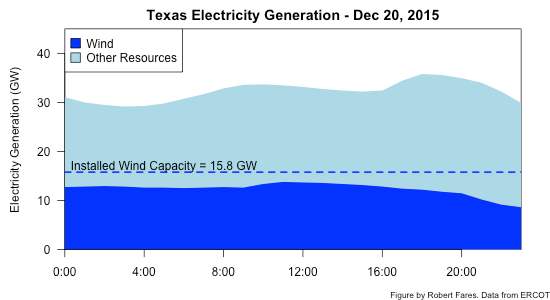
The duration of the record is a big deal because it shows that the rest of the Texas grid can handle a whole lot of wind energy for an extended period of time without suffering instability or brownouts that some predicted. Texas was able to balance the intermittent wind because it has a lot of natural gas power plants, which can adjust their power output more quickly than coal-fired power plants. Considering this fact, it seems like a happy coincidence that market forces are transitioning the U.S. electricity system toward a mix of renewable energy and natural gas.
How Did Texas Get Here?
Texas’s latest wind energy milestone is the culmination of years of forward-looking policy and steady wind energy development.
Despite its reputation as a pro-fossil-energy, anti-renewable-energy state, Texas was the second state after Iowa to pass a renewable portfolio standard, a policy which requires a certain amount of electricity come from renewable sources. Furthermore, Texas invested billions in high-voltage power lines linking Texas cities to windy West Texas way back in 2008. The so-called “Competitive Renewable Energy Zones” (CREZ) wind energy transmission project is one of the key reasons Texas calls itself the national leader in wind energy today, with over double the wind generation capacity of any other state.
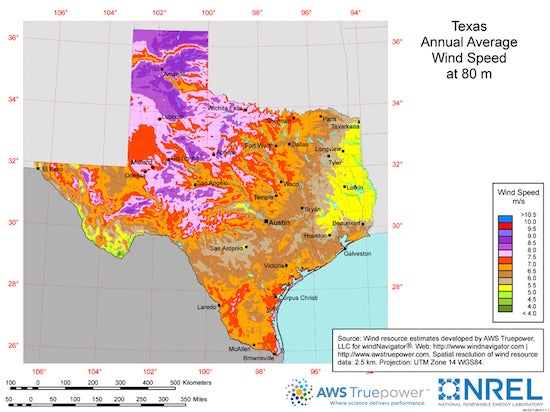
West Texas and the Texas Panhandle have sustained wind speeds that make the regions very attractive to wind energy developers. (Source: U.S. Department of Energy)
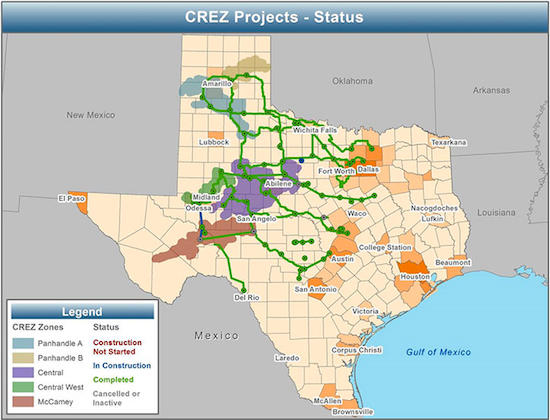
Texas invested in transmission lines linking wind-rich "competitive renewable energy zones" to the state's largest cities back in 2008, helping Texas become the national leader in wind energy today. (Source: Public Utility Commission of Texas)
What About When the Winds Aren’t Record Breaking?
Of course, it’s important to put Texas’s latest wind energy record in context — because by definition a record is an exceptional event.
Let’s look at the entirety of the week during which the latest wind energy record occurred. Wind energy was producing at exceptional levels for essentially the entirety of December 19 and 20. However, wind production was significantly lower for most of December 18 and December 21. Wind energy is great when the wind is blowing — but it's important to have flexible resources like natural gas or storage in the system that can ramp up when the wind ramps down.
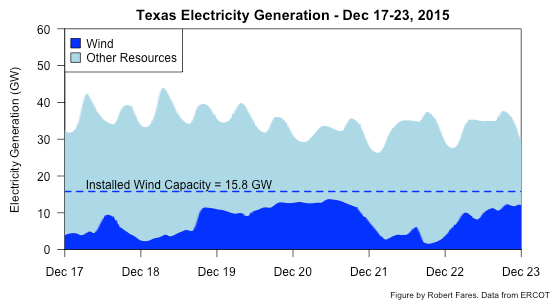
Zooming out further to examine temporal variations in wind energy production over a year, we see that wind energy is not only intermittent from one day to the next, but also tends to produce more in the winter than in the summer, when electricity demand is highest. The data in the figure below are for 2014, because 2015 data are not yet available.

The wind pattern shown in the figure above is a product of the fact that most of Texas's wind resources are installed in West Texas today, where the winds peak in the winter and decline in the summer. However, winds along the Texas gulf coast are a lot more plentiful during the summer months than they are in West Texas, so wind developers are moving to capture those winds and the corresponding high summer electricity prices. We might see more summer wind energy production as more and more coastal wind farms come online.
What's Next?
Perhaps the most exciting thing about the latest wind energy record is that it is a small glimpse of what will become commonplace as Texas adds more wind energy — especially in light of the fact that the U.S. congress just extended the wind energy production tax credit for an additional five years. With more flexible natural gas generation and storage on the horizon for Texas, it seems like the state's grid operator will continue to impress with its ability to integrate wind and other renewables. We'll have to wait and see.
Update: The Electric Reliability Council of Texas posted the annual energy generation by fuel type the day after this post was first published. The data are provided below.
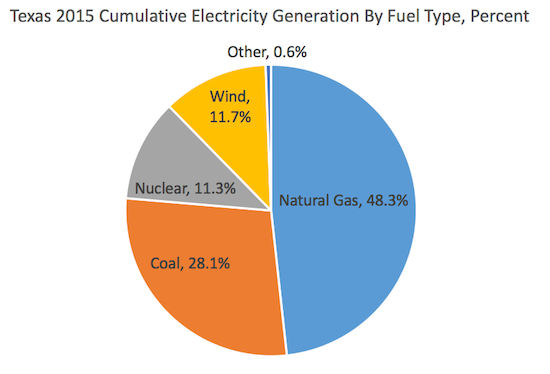
Data from The Electric Reliability Council of Texas (ERCOT). Data for ERCOT region only.
Credits:
Wind data from The Electric Reliability Council of Texas (ERCOT)
Agenda image: Duke Energy via Flickr Creative Commons